Nepal and Bhutan are hidden gems of South Asia. Nepal, home to the planet’s highest peak, is rich in vibrant culture and serene natural settings. Her more secluded neighbour, Bhutan, is an intriguing country where age-old tradition is still preserved in the midst of globalisation.
Most tourists who’d like to experience Bhutan have to do so with a tour operator rather than independently due to restrictions imposed by the government. Therefore, this adapted itinerary takes the cue from EU Asia, which has carefully crafted an 8D7N trip that covers both Nepal and Bhutan. You may refer to this while planning your trip, or you could simply sign up and let them take care of you.
Without further ado, here’s how the trip would unfold:
DAY 1: Home → Kathmandu → Patan
On your first day, deplane at the capital of Nepal, Kathmandu, and make your way down to Lalitpur Metropolitan City, historically known as Patan. Yes, you’ll be skipping Kathmandu for now but don’t worry because you’ll be revisiting it properly at the end of your trip.

Image credit: Jean-Pierre Dalbéra
The third largest city in Nepal and a centre of fine art, Patan is where you can get an essence of the Buddhist and Hindu cultures of the country. Take a stroll around Patan Durbar Square where incredible landmarks, such as the Old Royal Palace, Golden Temple and Mahaboudha Temple embellish the grounds.
Enjoy the sight of old houses with wood carvings, and drop by the many shops selling wood and metal handicrafts as well as traditional paintings. You could also try to visit the legendary Living Goddess Kumari, a prepubescent girl worshipped by Hindus and believed to be the connection between this world and divinity.
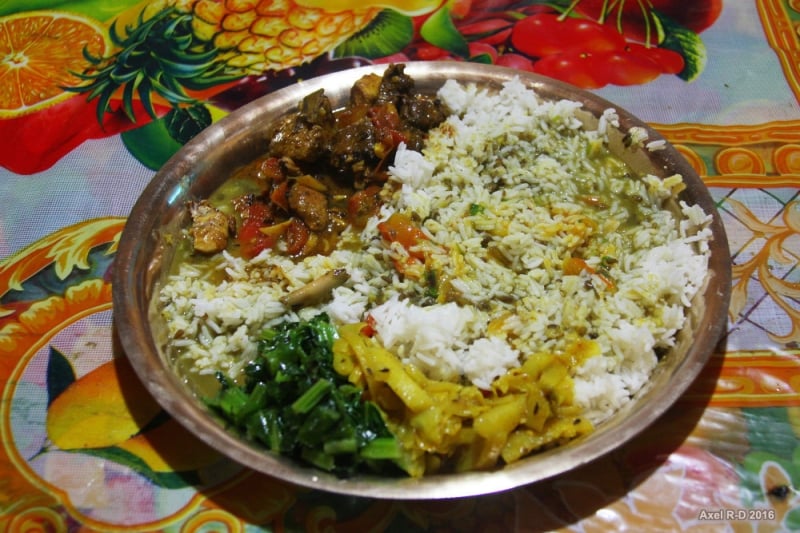
Image credit: Axel Drainville
End your day at a Nepalese restaurant, trying dishes like dal bhat (rice and lentils) or momo (Nepalese dumplings), and wash down your hearty meal with local rice wine known as raksi.
DAY 2: Kathmandu → Bhutan → Paro/ Thimpu
Today, you’ll be flying to Bhutan. Only two airlines operate flights into the Hermit Kingdom (Drukair and Bhutan Airlines), and you can catch a connecting flight via Kathmandu. The plane lands at Paro Airport, the only international airport in Bhutan. From Paro, head to the capital of Bhutan, Thimphu. Your Bhutanese experience officially begins here!
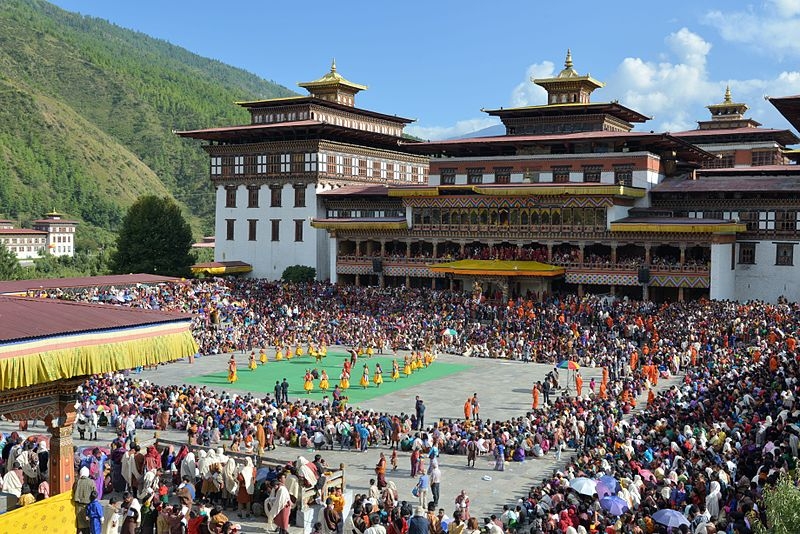
Image credit: Cfynn
Start your sightseeing with Tashichho Dzong, a Buddhist monastery and the seat of Bhutan’s civil government. The government has worked together with the Bhutanese monarchy to run the country since 1907. Tashichho Dzong houses the offices and the king’s throne room.
Apart from Tashichho Dzong, there’s also plenty to see and do in Paro. For the romantic at heart, make a short drive to up to Chele La Pas and have a picnic against an incredible backdrop of the Himalayas and Mount Jumolhari.
You could also visit the National Museum to learn about the history and heritage of Bhutan. Apart from that, admire the crescendo of Bhutanese architecture by visiting the towering Paro Dzong fortress overlooking the valley.
For food, you might want to reserve a table at Tou Zaiga Restaurant. It is here where Bhutan’s very best trainee chefs hone their craft. Expect impeccable attention to detail as you dive into a meal of exuberant flavours, all prepared with fresh local produce.
DAY 3: Thimphu → Dochula Pass → Punakha
Kickstart your first full day in the land of happiness by visiting the colossal Buddha statue sitting atop a hill at Kuensel Phodrang, also known as the Buddha Point of Thimpu. Gazing down from the hilltop, the statue casts a benevolent aura around the city. Down the road is the Memorial Chorten, a prominent stupa that is detailed with bells and golden spires gleaming in the sun. This stupa was built to honour the kingdom’s old king.
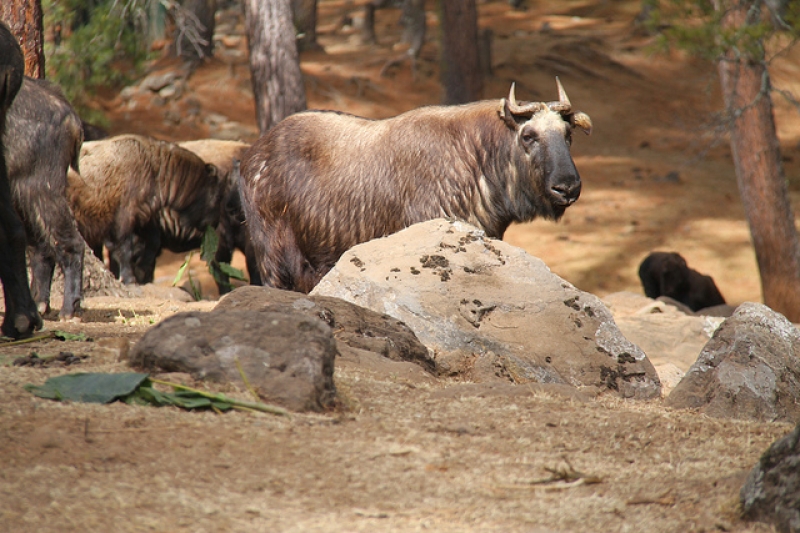
Image credit: Frédéric Gloor
Just 15 minutes from the city, you can meet the Takins. These stocky goat-antelope hybrids are the national animals of Bhutan and they can be found grazing at the Motithang Takin Preserve.
Before leaving Thimpu, drop by a paper factory to watch how mulberry can be processed using ancient methods to manufacture traditional paper. You can even purchase a paper product at the end of the tour. Following that, visit the Post Office to customise a postage stamp and send off your unique postcard.
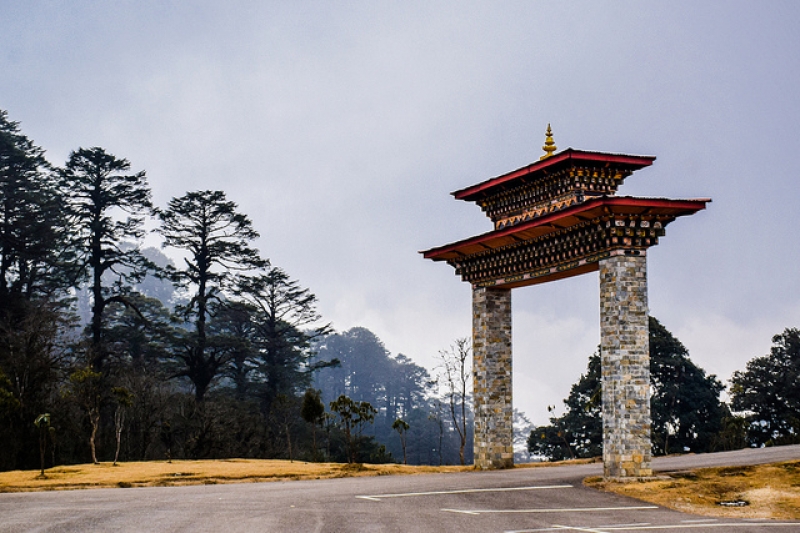
Image credit: Mashrik Faiyaz
Set free the photographer in you as you set off for Punakha, the old capital of Bhutan, passing through the Dochula Pass. This passageway soars 3,150 metres above sea level and offers a feast for your eyes with breathtaking views of the high crowns of the Eastern Himalayas.
Enroute, peel your eyes off the road and embark on a hike up a small hill through mustard and paddy fields to visit the last sightseeing stop for the day: Chimi Lhakhang. This is an auspicious 15th-century fertility monastery in which pilgrims travel to from far and wide in hopes of conceiving a child. In line with this, there are plenty of phallus symbols found throughout the site.
Even though most bars and clubs are closed on Tuesdays (designated no-alcohol day in Bhutan), the nightlife in Punakha is quite interesting, to say the least. While the establishments here are much smaller, hitting up a Bhutanese bar is an experience of its own. Sample local brews, enjoy musical performances with traditional Bhutanese music and dance the night away at a local nightclub.
If you wish to experience what typical Bhutanese youngsters in the town would call ‘a night out’, speak to your guide and he/she can take you. And while Bhutan is known to be a relatively crime-free country, it’s still best to enjoy responsibly.
DAY 4: Punakha → Paro

Standing near the meeting point of Punakha’s Pho Chhu (father) and Mo Chhu (mother) rivers in the Wangdue Valley is the Punakha Dzong. This imposing fortress stands tall with its central structure, utse, towering at 1,200 metres.
Despite looking regal before a beautiful mountainous backdrop, the walls of this edifice has seen the wrath of Mother Nature through numerous fires, floods and earthquakes. Historically, this was the place where all of the country’s kings were crowned. Until the mid-1950s, it served as the seat of the government.
From the dzong, you can take a thrilling walk across the Punakha Suspension Bridge to some of the smaller villages on the other side. Built high above the Po Chu River, the bridge offers unparalleled views of the valley below. It’s also the second longest suspension bridge in Bhutan, so hopefully, your legs won’t turn into jelly!
If you have the time, you should also check out incredible places like the Khamsum Yulley Namgyal Chorten and Jigme Dorji National Park, home to a multitude of flora and fauna including snow leopards and red pandas. In addition, if you’re up for a scenic walk through lush greenery, you would want to make arrangements to visit the Samtengang Winter Trek as well.
After visiting the attractions in Punakha, it’s time to head to Paro via Thimpu. A non-stop drive would take three full hours.
DAY 5: Paro
On your fifth day, you’ll wake up in Paro because you simply cannot leave Bhutan without seeing the iconic Taktsang Monastery. Known as the Tiger’s Nest, this 17th-century monastery is wedged somewhat precariously on the face of a cliff.
To catch a glimpse of it, you will need to hike up for an hour and a half to a viewpoint. Catch your breath while enjoying the view – there’s still an hour of hiking to go before you can finally set foot in the Tiger’s Nest.
Time to slow down the pace after the back-breaking morning. In the afternoon, continue your way to a local farmhouse for a peek into the villagers’ way of life. On top of seeing how a traditional farmhouse looks like from the inside, you can also experience the local hospitality and taste ara, the Bhutanese rice wine.
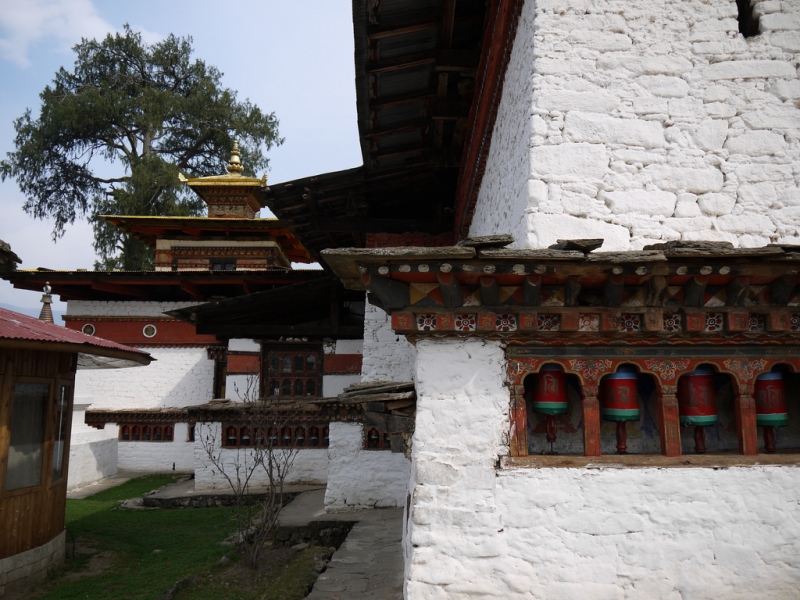
Image credit: Olivier Lejade
Upon reaching Paro, tour the country’s first and oldest temple, Kyichu Lhakhang. Age does not diminish the beauty of this temple which was built by a Tibetan king in the 7th century. Behind the golden door at the entrance lies beautiful statues, wall paintings, and prayer wheels that are spun by elderly pilgrims.
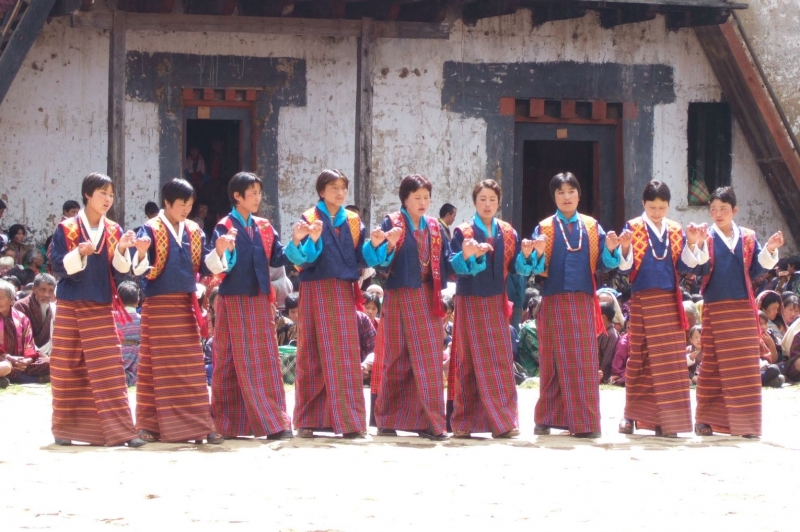
Image credit: Christopher J. Fynn
Depending on the tour, you might even have the chance to watch a Bhutanese cultural show and don the traditional costumes before you leave the country. Kira is an ankle-length dress with a blouse for the ladies and gho is a knee-length robe that’s tied at the waist for the men.
DAY 6: Paro → Kathmandu → Nagarkot
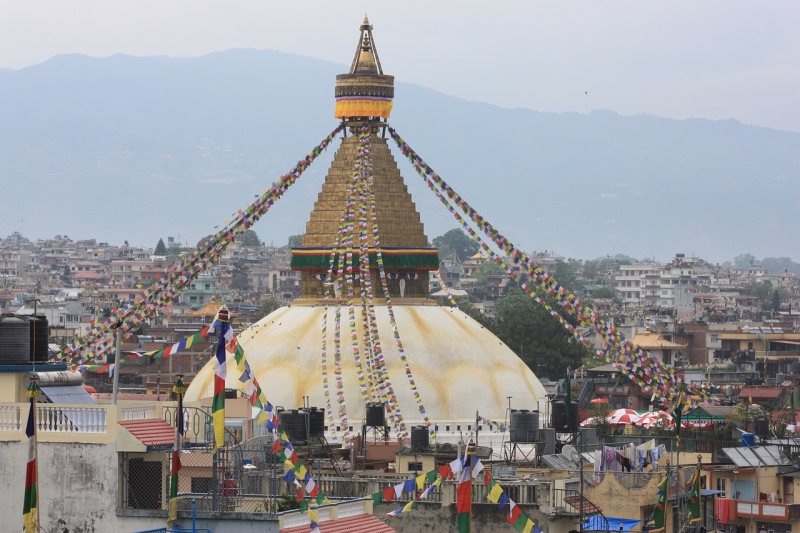
This day marks the end of your time in Bhutan, but hold your tears because your adventure in Nepal continues. Head to the airport and say hello again to Kathmandu, a city with no less than seven UNESCO World Heritage Site, a testament to the many cultural treasures that the city holds.
One of them is Boudhanath Stupa, the largest stupa in the world and the beacon of Tibetan Buddhism. Walk among the crowd of monks and worshippers circling the stupa or climb up to the white dome for an aerial view of the area.

Image credit: Luca Galuzzi
Another gem in Kathmandu is the extravagant Pashupatinath Temple, a 5th-century Hindu temple built for Lord Shiva, the Hindu supreme deity. Another of Kathmandu’s UNESCO World Heritage Sites, this temple which is located along the banks of the Bagmati River serves as an important pilgrimage zone for Hindu devotees who perform venerations, take part in religious rituals and cremate the dead.
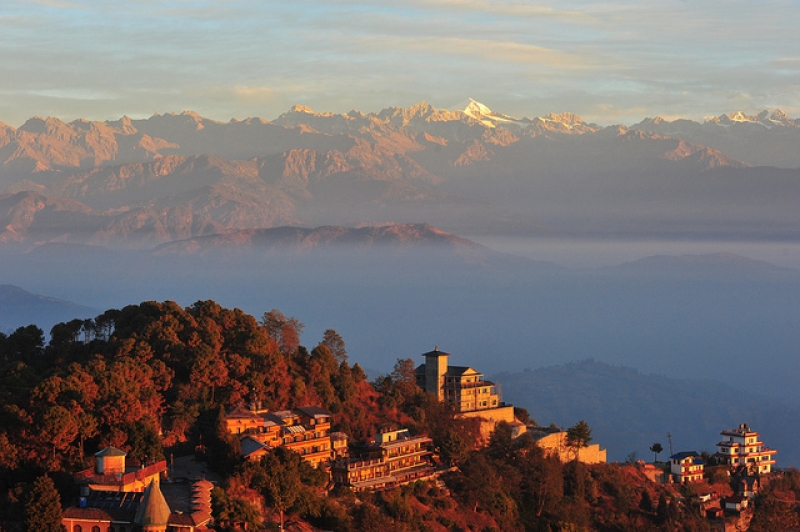
Image credit: Neil Young
End your day on a peaceful note at Nagarkot, a picturesque village about an hour and a half hour away from Kathmandu. It’s famed for its picture-perfect views of the Himalayas; on a clear day, you can even see Mount Everest to the northeast. The rich natural beauty of this area is accompanied by tranquillity, and the scenery is unparalleled especially when the sky transforms into an artist’s palette during sunset and sunrise.
DAY 7: Nagarkot → Kathmandu
Wake up to another beautiful day and take the chance to visit a viewing point near the village. It’s highly unlikely that you’d turn down an opportunity for photo-taking in this part of the country. Bid goodbye to the mountain views and make your way back to Kathmandu for your last full day in the country.
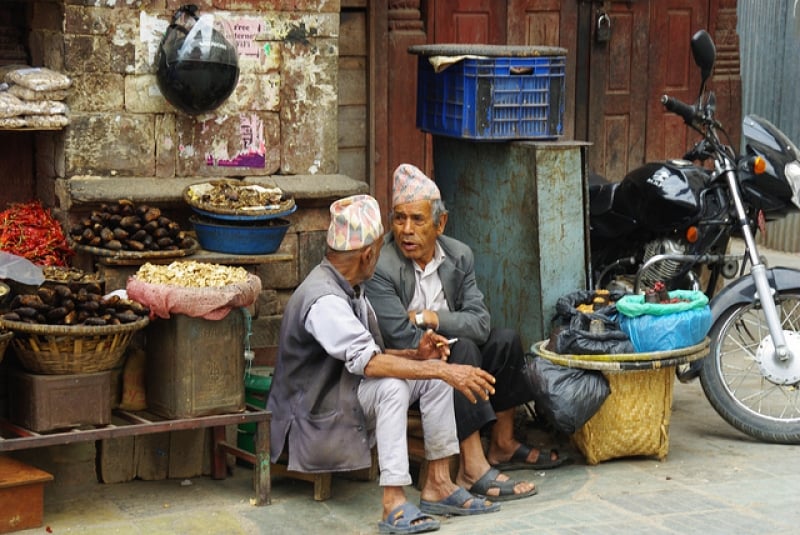
Image credit: Jerome Bon
Step into Kathmandu’s Durbar Square to be at the centre of city life. The Hanuman Dhoka Palace Complex, the previous residence of royalty until the 19th century, as well as the Kumari Ghar, the temple of the Living Goddess of Nepal, are among the many sights you can take in here. Fifteen minutes away by car is Swayambhunath Stupa, also known as the Monkey Temple, a grand site that’s nestled atop a hill, its golden spire gleaming as it overlooks the city.
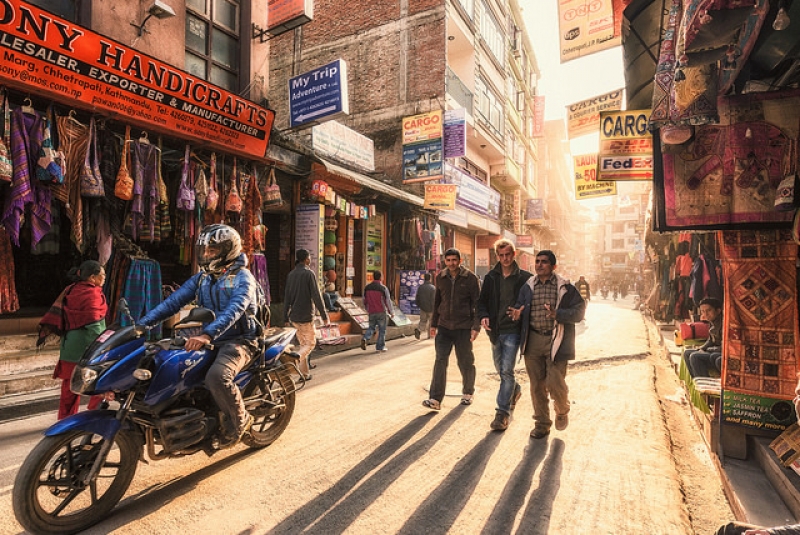
Image credit: Esmar Abdul Hamid
As you’d probably want to pack home some souvenirs, wander around the tourist-oriented Thamel Street where you can find handicrafts, clothes, hiking gear, books, and many more items. Don’t be shy to haggle, and do wander into the little alleys for surprising finds.
DAY 8: Kathmandu → Home
Alas, you’ve come to the end of your adventure exploring the two neighbouring countries of Nepal and Bhutan. If your last day in Kathmandu is a Saturday, then you’re in fine luck because that’s the only day of the week when Le Sherpa Farmer’s Market opens.
This weekly market is the best place to sample the freshest produce in Kathmandu. I’m talking about crisp vegetables, fresh bread, and Himalayan milk cheese. You can even grab a cup of freshly brewed coffee to start your day.
If it’s not a Saturday though, don’t fret because you can visit the bustling markets of Durbar Square early in the morning too. It’s a great way to spend your last day in the city.
After a (hopefully) hearty breakfast, hop on the flight home with all your good memories.

Winner of TripZilla Excellence Awards – Best for Bhutan, EU Asia has set the bar for all tour agencies when it comes to organising an enchanting tour to Bhutan. While the highlighted tour spans two countries, EU Asia also provides 5D4N and 7D6N tours dedicated to Bhutan.
All of their packages are well-balanced, with plenty of must-see attractions, cultural experiences, and also immersions in nature. At the same time, the itineraries are not too taxing on travellers with overly-lengthy drives on the road. So if you’re up for a trip to Bhutan, be sure to make EU Asia your first stop! |






